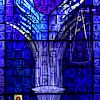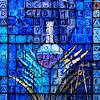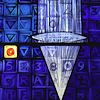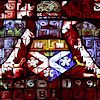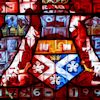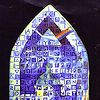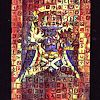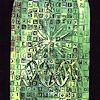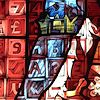WWW.GLASSPAINTER.COM
-ARCHITECTURAL GLASS ARTIST
University of Strathclyde Bi-Centenary Windows Windows
I still love this project.
The windows were commissioned to mark the Bi-Centenary of the founding of the institution that has become the University of Strathclyde.
It took me a little while to develop the concept that it is not buildings that make a house of knowledge, but access to information. That meant the passing on of knowledge using letters, numbers signs and symbols. That concept is the basis for these windows.
Bi-centenary Windows - University of Strathclyde
Material - Lamberts Flashed Glass
Technique - Extensive multi layered acid etching, traditional glass painting and silver staining
Dimensions - Dim. 3 @ 2140mm x 700mm
Explanation Text
Brief
The purpose of this brief is not to restrict the imagination
of the artist, but to set the boundaries within which the artist has the
freedom to create. Having said this, the windows are being sponsored and
the sponsors wish to be given the opportunity to comment on the design
as do senior officers of the University. The artist is likely to consider
a number of preliminary design solutions and of these one solution will
emerge as the preferred option. The artist is therefore required to present
his preliminary proposals to a group, which will include the sponsors
and senior officers. After this group meeting, the artist will have
complete freedom to develop his design to completion….
…The windows will celebrate 200 years of the educational achievement over the period 1796 - 1996. The starting point is John Anderson, the founder. In January 1996 the University will be granted supporters to its crest by the Lord Lyon Court and the new crest or coat of arms will be the Bicentenary logo.
A requirement is that the words "200 years of useful learning 1796 - 1996" are included in the design. In the event that the artist decides to use the new crest as an image, the words "useful learning" appear on the crest and therefore the design should include the words "Bicentenary 1996".
There were also several appendices attached to the brief giving a short history of the University and some background information about important figures in the history of the institution. To conclude there was the location, the budget and the time scale and date of the unveiling ceremony.
A requirement is that the words "200 years of useful learning 1796 - 1996" are included in the design. In the event that the artist decides to use the new crest as an image, the words "useful learning" appear on the crest and therefore the design should include the words "Bicentenary 1996".
There were also several appendices attached to the brief giving a short history of the University and some background information about important figures in the history of the institution. To conclude there was the location, the budget and the time scale and date of the unveiling ceremony.
The Windows
The Concept
That which allows a university or any other educational establishment to function as a place where knowledge is disseminated is not a collection of buildings, it is the written language, the alphabet, numbers, signs and symbols. Without these then learning would depend upon oral transmission of knowledge and memory.
My intention was to indicate that this concept of a second University for Glasgow which began so humbly in the Trades Hall in Glasgow should have grown and developed into the institution we see today which is respected world wide.
At the time of. Being commissioned to undertake this project, I was, very kindly, given access to a manuscript of a history of the University by Professor John Butts. This was invaluable in my research.
The three windows are predominantly blue, red and green, the three primary colours of light.
That which allows a university or any other educational establishment to function as a place where knowledge is disseminated is not a collection of buildings, it is the written language, the alphabet, numbers, signs and symbols. Without these then learning would depend upon oral transmission of knowledge and memory.
My intention was to indicate that this concept of a second University for Glasgow which began so humbly in the Trades Hall in Glasgow should have grown and developed into the institution we see today which is respected world wide.
At the time of. Being commissioned to undertake this project, I was, very kindly, given access to a manuscript of a history of the University by Professor John Butts. This was invaluable in my research.
The three windows are predominantly blue, red and green, the three primary colours of light.
The Blue Window
This window has images and words relating to the establishment of the institution and about John Anderson the founder of Anderson's Institution.
At the peak is the symbol of the prism splitting the light into its component colours. This can be seen as a symbol for a university which is divided into component parts i.e. the faculties and was also something which was demonstrated in the teaching of Natural Philosophy which we now know as science. In this area there are contained some aspects of the work and life of John Anderson, dates of his birth and death and a contemporary nickname for him, 'Jolly Jack Phosphorous', he had a fondness for causing explosions.
Main text inclusions are: Br> the initials of the first trustees, JW, PW, JM, WM, JC, WR, JF, JP.
The name Anderson's Institution. (the first name)
The date 8th Nov. 1796 (the first lecture)
Dr. T. Garnett, (the first lecturer)
8pm Trades Hall. (place of first lecture) £31.10/- p.a. (rent for the lecture theatre)
In this area of the window is an illustration of the Trades Hall where the first lectures were held.
Other words and texts included here.
Popular Chemistry, Dr. G. Birkbeck, Mechanics, Natural Philosophy, Medicine, Dr. A Ure.
Various other words and symbols are included.
Some of the early alchemic symbols have been included, particularly for the four elements of fire, air, water and earth from which it was believed that everything was composed. These symbols are used extensively throughout this window and particularly in the border. There are also the early symbols for the planets and for male and female in roughly equal quantities.
It was part of the instruction from John Anderson that females should also be included and welcomed in his university.
Some of the main text books used for teaching at the time were written by John Anderson and called Anderson's Institutes.
In the lower half of this window are contained illustrations of experiments and apparatus which were described in Anderson's Institutes. I have chosen experiments and statements which were possible to illustrate.
In the books it states that 1 cubic inch of gold is equivalent in weight to 19.64 cubic inches of water. This is quite an interesting number as the establishment of the modern University took place in 1964. The same cubic inch of gold, it is stated, can be divided into 9,523,809,523 individual pieces, all visible to the naked eye.
There is a representation of a flame test, a test for the presence of an element by the colour it or its compounds give to a bunsen burner flame. I have not used a bunsen burner flame but used fire to represent this.
It is also stated that light is fire which moves in straight lines.
Below is a quotation from Anderson's Institutes.
Sect V
Prop i
One grain of gold may be divided into into two millions of parts; and a cubic inch of gold, into nine billions, five humdred and twenty three millions, eight hundred and nine thousand, five hundred and twenty three parts; each of which may be distinctly seen by the naked eye.
9,523,809,523.
The first is produced by the application of fire to Nitre, and various bodies, The second by the application of Fire to Minium, and the vitriolic Acid. The third by throwing the sunsrays with a burning glass apon Minium. The fourth by the application of common fire to the Vitriolic acid and copper, And the sixth by joining mercury and the nitrous acid together.
At the peak is the symbol of the prism splitting the light into its component colours. This can be seen as a symbol for a university which is divided into component parts i.e. the faculties and was also something which was demonstrated in the teaching of Natural Philosophy which we now know as science. In this area there are contained some aspects of the work and life of John Anderson, dates of his birth and death and a contemporary nickname for him, 'Jolly Jack Phosphorous', he had a fondness for causing explosions.
Main text inclusions are: Br> the initials of the first trustees, JW, PW, JM, WM, JC, WR, JF, JP.
The name Anderson's Institution. (the first name)
The date 8th Nov. 1796 (the first lecture)
Dr. T. Garnett, (the first lecturer)
8pm Trades Hall. (place of first lecture) £31.10/- p.a. (rent for the lecture theatre)
In this area of the window is an illustration of the Trades Hall where the first lectures were held.
Other words and texts included here.
Popular Chemistry, Dr. G. Birkbeck, Mechanics, Natural Philosophy, Medicine, Dr. A Ure.
Various other words and symbols are included.
Some of the early alchemic symbols have been included, particularly for the four elements of fire, air, water and earth from which it was believed that everything was composed. These symbols are used extensively throughout this window and particularly in the border. There are also the early symbols for the planets and for male and female in roughly equal quantities.
It was part of the instruction from John Anderson that females should also be included and welcomed in his university.
Some of the main text books used for teaching at the time were written by John Anderson and called Anderson's Institutes.
In the lower half of this window are contained illustrations of experiments and apparatus which were described in Anderson's Institutes. I have chosen experiments and statements which were possible to illustrate.
In the books it states that 1 cubic inch of gold is equivalent in weight to 19.64 cubic inches of water. This is quite an interesting number as the establishment of the modern University took place in 1964. The same cubic inch of gold, it is stated, can be divided into 9,523,809,523 individual pieces, all visible to the naked eye.
There is a representation of a flame test, a test for the presence of an element by the colour it or its compounds give to a bunsen burner flame. I have not used a bunsen burner flame but used fire to represent this.
It is also stated that light is fire which moves in straight lines.
Below is a quotation from Anderson's Institutes.
Sect V
Prop i
One grain of gold may be divided into into two millions of parts; and a cubic inch of gold, into nine billions, five humdred and twenty three millions, eight hundred and nine thousand, five hundred and twenty three parts; each of which may be distinctly seen by the naked eye.
9,523,809,523.
The first is produced by the application of fire to Nitre, and various bodies, The second by the application of Fire to Minium, and the vitriolic Acid. The third by throwing the sunsrays with a burning glass apon Minium. The fourth by the application of common fire to the Vitriolic acid and copper, And the sixth by joining mercury and the nitrous acid together.
The Red Window
.
This window contains the new crest which was the logo and centerpeice for the Bicentenary and all the various changes of names and most of the amalgamations
which have created the University of Strathclyde. The words, 200 Years of Useful Learning and Bicentenary are also included. In the corners are the emblems of the two donors and the words Trades House and The Miller Foundation and somewhere, the signature of the artist.
The various name begin at the top and work generally horizontally downward.
These are most of the name changes and amalgamations of the core institution.
Anderson's Institution
Anderson's University
Athenaeum
Anderson's College
Glasgow and West of Scotland Technical College
Royal Technical College
Royal College of Science and Technology
Scottish College of Commerce
Scottish College of Commerce
University of Strathclyde
Jordanhill College of Education
In the upper part of the window is the date 1796. The name Anderson runs vertically with the other names of: Glasgow, Institution, Forbes, University and collage crossing through it. The name Atheneaum runs also vertically in this area.
Then is the text 200 Years of Useful Learning
The dates on either side of the crest 1796 - 1996
The word Bi-centenary
Contained here are also the names Young and Livingston
Directly beneath this the word College runs vertically. The institution in this time was a college.
Crossing through this word are the words
Technical, Glasgow and West, Scotland, Royal and the date 1956, Science, College, technology.
The word Scottish runs vertically in the left hand border and relates to the word commerce running horizontally.
Next is the date 1964, when the University of Strathclyde came into being.
The date 1993 when it amalgamated with Jordanhill College
Dates relating to the institution.
1796 Anderson's Institution
1828 Anderson's University
1823 Glasgow Mechanics Institution split away from the Anderson
1877 Anderson's College
1887 Anderson's College, the College of Science and Arts (was this formerly the Mechanics Institution) and Allan Glen's and the Atkinson what is the Atkinson, see Prof. Bone's Notes)
They merged to become the Glasgow and West of Scotland Technical College
1887 The medical School was detached
1908 The Weaving, Dyeing, and printing College was absorbed by the Technical College
1912 Changed to the Royal Technical College
The George St. building still bears the name 'The Royal College
1919 recognised as a 'University College'
1956 became the Royal College of Science and Technology. (RCST)
1964 was created 'the University of Strathclyde'
1993 Jordanhill College of Education was amalgamated
The various name begin at the top and work generally horizontally downward.
These are most of the name changes and amalgamations of the core institution.
Anderson's Institution
Anderson's University
Athenaeum
Anderson's College
Glasgow and West of Scotland Technical College
Royal Technical College
Royal College of Science and Technology
Scottish College of Commerce
Scottish College of Commerce
University of Strathclyde
Jordanhill College of Education
In the upper part of the window is the date 1796. The name Anderson runs vertically with the other names of: Glasgow, Institution, Forbes, University and collage crossing through it. The name Atheneaum runs also vertically in this area.
Then is the text 200 Years of Useful Learning
The dates on either side of the crest 1796 - 1996
The word Bi-centenary
Contained here are also the names Young and Livingston
Directly beneath this the word College runs vertically. The institution in this time was a college.
Crossing through this word are the words
Technical, Glasgow and West, Scotland, Royal and the date 1956, Science, College, technology.
The word Scottish runs vertically in the left hand border and relates to the word commerce running horizontally.
Next is the date 1964, when the University of Strathclyde came into being.
The date 1993 when it amalgamated with Jordanhill College
Dates relating to the institution.
1796 Anderson's Institution
1828 Anderson's University
1823 Glasgow Mechanics Institution split away from the Anderson
1877 Anderson's College
1887 Anderson's College, the College of Science and Arts (was this formerly the Mechanics Institution) and Allan Glen's and the Atkinson what is the Atkinson, see Prof. Bone's Notes)
They merged to become the Glasgow and West of Scotland Technical College
1887 The medical School was detached
1908 The Weaving, Dyeing, and printing College was absorbed by the Technical College
1912 Changed to the Royal Technical College
The George St. building still bears the name 'The Royal College
1919 recognised as a 'University College'
1956 became the Royal College of Science and Technology. (RCST)
1964 was created 'the University of Strathclyde'
1993 Jordanhill College of Education was amalgamated
The Green Window
In the third window I have included some of the most important factors and discoveries of our century.
By their nature, stained glass windows become historical documents. It is interesting to note how quickly things become out of date and old fashioned. Many of the elements contained in this window will have become obsolete in fifty years or even earlier and possibly some of the elements contained within this window will look as naive and simplistic as we perceive the contents and experiments in the blue window.
The life of stained glass window can span the centuries.
The names of the five faculties:
Science, Engineering, Arts and Social Sciences, Business, Education.
Symbols included in this window.
At the very top of the window is a reference to the petrol engine.
A symbolic representation of an atom.
The double helix of DNA.
A television screen.
The Mercator projection of the globe.
The names Einstein and the equation E=mc2 as one of the defining discoveries of this century.
The association of the following people to the University of Strathclyde has been marked by the inclusion of their names in this window.
John Logie Baird - Associate of the Royal Technical College.
Lord Reith - Attended the Technical College. First General Manager of the BBC.
Samuel Curran - Principal of the Royal College of Science and Technology, first Principal of the University of Strathclyde. Worked on the Manhattan Project.
Lord Todd - Chancellor of the University since its inception in 1964. Nobel prize winner. Vit-E, Vit-B.
Other words included in this panel are:
quantum, relativity, fission, superstring, greenhouse gases, ozone.
At the base the majority of the squares are filled with 0 and 1, the binary system representing all things digital, the first line, QWERTY of a typewriter or computer keyboard and the f1, f2, f3, etc. function keys, a telephone touch-pad indicating the telephone system and the information superhighway and words are included relating to this.
By their nature, stained glass windows become historical documents. It is interesting to note how quickly things become out of date and old fashioned. Many of the elements contained in this window will have become obsolete in fifty years or even earlier and possibly some of the elements contained within this window will look as naive and simplistic as we perceive the contents and experiments in the blue window.
The life of stained glass window can span the centuries.
The names of the five faculties:
Science, Engineering, Arts and Social Sciences, Business, Education.
Symbols included in this window.
At the very top of the window is a reference to the petrol engine.
A symbolic representation of an atom.
The double helix of DNA.
A television screen.
The Mercator projection of the globe.
The names Einstein and the equation E=mc2 as one of the defining discoveries of this century.
The association of the following people to the University of Strathclyde has been marked by the inclusion of their names in this window.
John Logie Baird - Associate of the Royal Technical College.
Lord Reith - Attended the Technical College. First General Manager of the BBC.
Samuel Curran - Principal of the Royal College of Science and Technology, first Principal of the University of Strathclyde. Worked on the Manhattan Project.
Lord Todd - Chancellor of the University since its inception in 1964. Nobel prize winner. Vit-E, Vit-B.
Other words included in this panel are:
quantum, relativity, fission, superstring, greenhouse gases, ozone.
At the base the majority of the squares are filled with 0 and 1, the binary system representing all things digital, the first line, QWERTY of a typewriter or computer keyboard and the f1, f2, f3, etc. function keys, a telephone touch-pad indicating the telephone system and the information superhighway and words are included relating to this.





